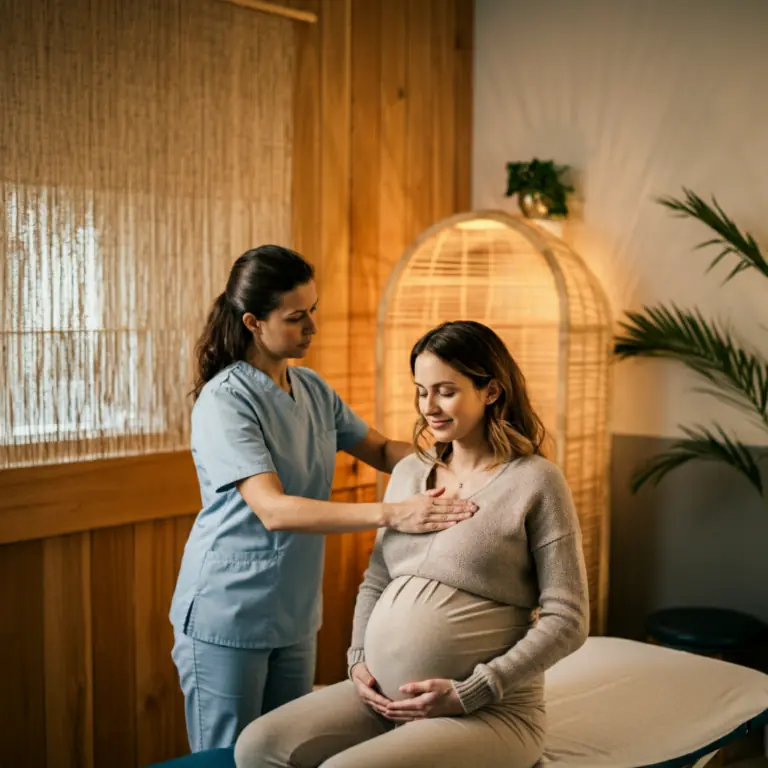
Pregnancy is a wonderful experience for many, but research shows that most people will suffer some pain or discomfort during this time. In fact, between 50% and 66% of pregnant individuals experience low back pain during pregnancy (1,2,3,4).
Understanding the Physical Changes of Pregnancy
While many are aware of hormonal changes and symptoms like morning sickness, the mechanics of how the body adapts to pregnancy are often less understood. Physical changes start early in pregnancy, with the uterus becoming more upright during the first 12-16 weeks. Ligaments supporting the uterus adjust, and any restrictions or adhesions in these ligaments may cause pain, often felt as a deep burning sensation.
As pregnancy progresses, the uterus moves into the abdominal cavity, pushing abdominal organs upward and expanding the rib cage. This can lead to mid-back or rib pain, particularly if there are underlying restrictions in the thoracic area. The shift in the body’s centre of gravity and spinal curve adjustments may further contribute to discomfort.
Common Causes of Pain During Pregnancy
- Low Back Pain – As the belly grows, the shift in body weight can lead to compression in the low back.
- Pelvic Pain – Increased pressure on the pelvis, particularly the sacroiliac joints and pubic symphysis, can lead to conditions such as symphysis pubis dysfunction (SPD).
- Neck, Shoulder, and Head Pain – Increasing breast size and spinal curve changes may strain the shoulders and neck, possibly causing headaches or fluid congestion in the arms.
- Rib and Thoracic Pain – The diaphragm and thoracic cage adjust to accommodate the growing baby, which can lead to pain if the body’s mobility is restricted.
How Osteopathy Can Help During Pregnancy
Osteopathy during pregnancy focuses on maintaining the body’s mobility and addressing any restrictions in the tissues that may contribute to pain or discomfort. Treatment may help ease:
- Low back pain
- Pelvic pain
- Rib and thoracic pain
- Headaches and neck pain
Additionally, stretches and exercises may be recommended to improve symptoms, and supports may be suggested to manage hypermobile joints that can result from pregnancy hormones.
The Role of Osteopathy in Labour and Delivery
The pelvic bones and muscles move and adapt to allow the birth of the baby. Our osteopaths are highly educated in the pelvic adaptations required for a vaginal delivery and provide education and treatment aimed at optimizing your body’s ability to create space during labour. Education focuses on the biomechanics of birth, how to support the natural physiology of birth, and pain science education.
Postpartum Osteopathy: Recovery After Birth
After delivery, the body undergoes a sudden shift. The baby, which previously supported the spine by occupying space, is no longer present, leaving the stretched abdominal muscles to support the body. Combined with the increased demands of caring for a newborn, this can lead to back, neck, shoulder, and pelvic pain.
Osteopathy in the postpartum period aims to address any lingering physical restrictions from pregnancy or delivery, helping new parents recover and adapt to their post-pregnancy bodies.
Your osteopath can provide postpartum pelvic health assessments, treatment, and advice on how to help the pelvic floor recover from birth. They can assess and manage diastasis of the rectus abdominus and educate on a safe return to exercise.
Osteopathic treatment during and after pregnancy can help manage the physical changes and discomfort associated with pregnancy. If you’re experiencing pain or difficulty adapting to pregnancy, consider booking an appointment with an osteopath to ease your journey.
References:
- Pennick V, Liddle SD. Intervention for preventing and treating pelvic and back pain in pregnancy. Cochrane Database Syst Rev. 2013.
- Andersson GB, Haagstad A, Jansson PO, Svensson HO. The relationship of low-back pain to pregnancy and gynaecological factors. Spine, 1990.
- Colliton J. Managing Back Pain During Pregnancy. MedGenMed. 1999.
- Galleher C. Functional Changes in Back Muscle Activity and Low Back Pain During Pregnancy. Physical Therapy, 1999.

